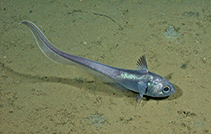| Family: |
Macrouridae (Grenadiers or rattails) |
| Max. size: |
84 cm TL (female) |
| Environment: |
bathydemersal; marine; depth range 277 - 909 m, non-migratory |
| Distribution: |
Eastern Pacific: off Vancouver Island, Canada to southern Peru. |
| Diagnosis: |
Dorsal spines (total): 2-2; Anal spines: 0-0. Snout short, narrow, bluntly pointed; terminal snout scute developed but not conspicuously; suborbital ridge low; underside of snout, most of the suborbital region, and anterior half of mandible without scales; cephalic pores of the lateralis system prominent. Pyloric caeca 24 to 58. Body scales densely covered with conical to narrowly lanceolate spinules in short, slightly convergent rows. Overall color is swarthy, blackish ventrally, with bluish tinge on abdominal region; oral and branchial cavities generally pale with some blackish areas; fins dusky to blackish, first dorsal fin slightly paler basally. |
| Biology: |
Food items are generally forcibly regurgitated by the fish's expunging gas bladder as it is hauled from the depths, but fish remains have been caught inside the mouth of a few individuals. Considered opportunistic feeders and will eat whatever animal food they encounter in the natural habitat as long as it is of appropriate size (Ref. 4525). |
| IUCN Red List Status: |
Not Evaluated (N.E.) Ref. (130435)
|
| Threat to humans: |
harmless |
Source and more info: www.fishbase.org. For personal, classroom, and other internal use only. Not for publication.

